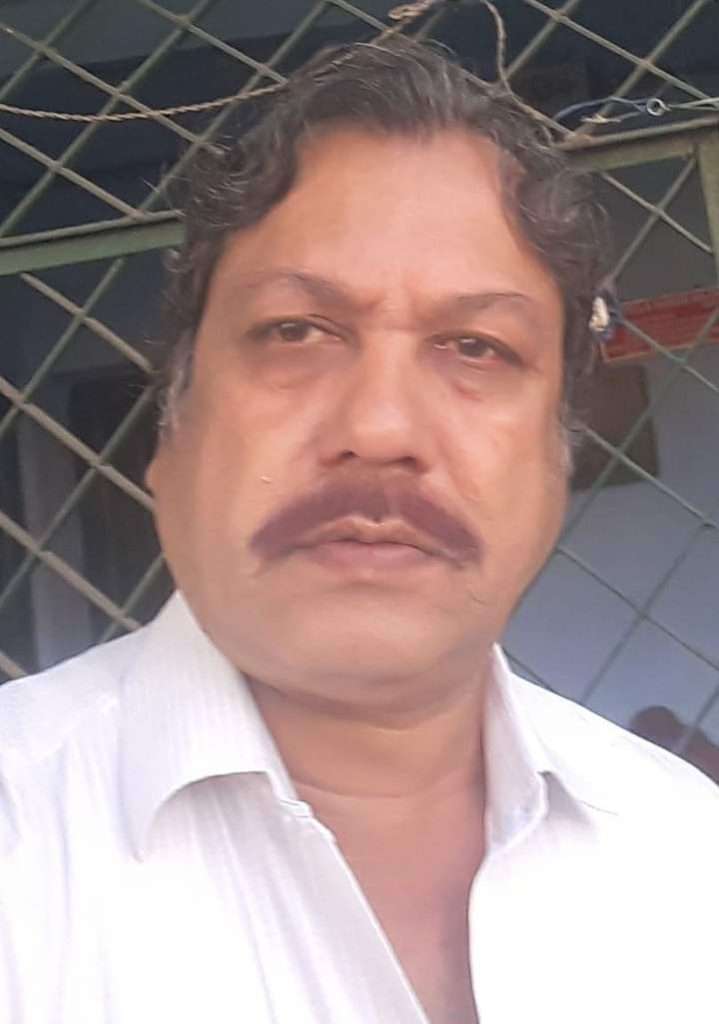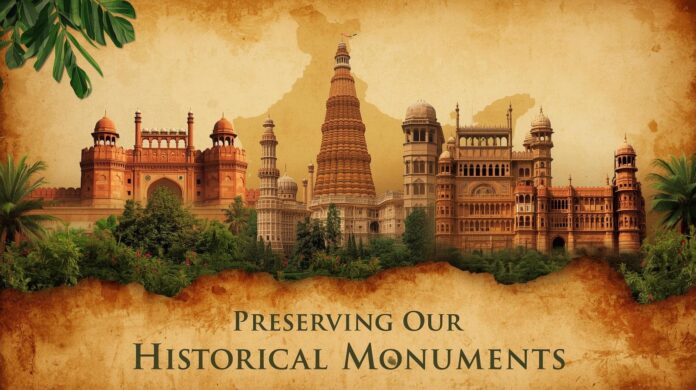Our country boasts of an ancient and great history, culture, and heritage. From Kashmir to Kanyakumari and from Dwarika to Kamakhya, this vast country is replete with historical monuments. But in some places, these are protected while in others they are on the verge of destruction. If we go to Delhi, Uttar Pradesh, or Rajasthan, we will see that the government has done a lot to protect the historical monuments. In different places in Delhi, even the tombs of kings, emperors, and sultans have been taken care of by developing gardens around them within wired fences. As a result, families with children are able to spend some time in the morning and evening in the gardens. Bigger monuments like the Qutab Minar and the Red Fort are being maintained properly. In big cities of Uttar Pradesh like Lucknow and Agra, the government has fixed an entrance fee for visiting the historical monuments, thereby earning some revenue for maintenance work. Since the Rajputs have had a long reign in Rajasthan, they have built many forts and other monuments in different parts of the state. The government has made commendable efforts for maintaining the same. Since arrangements have been made for food and comfortable stay in certain places, this has attracted tourists in large numbers. As a result, the government is not only earning revenue but tourism and the livelihood of local people are also getting a boost. The historical monuments are undoubtedly a centre of attraction for the people.
As in our country, in our state Odisha also, there are historical monuments in plenty. Old forts, royal palaces, high walls, and moats around forts, summer palaces, mutts, temples, and other monuments by kings and emperors are prominent. Prior to the time of independence, there were many princely states, both large and small, in Odisha. From Mayurbhanj to Jeypore and from Khariar to Kanika, there were royal palaces depending upon the status and financial resources of the kings. The kings had built forts and high walls for the safety of their kingdoms. Out of these, many have already been destroyed, while others are on the verge of destruction. The wall built by Balaram Dev, the first Chauhan king of Sambalpur in the old city, has long been destroyed. Now only a few towers can be seen on one bank of the river. There are Raja Bakhri, Rani Bakhri, old mutts, and temples in the old town which throw light on the past glory of Sambalpur. There has been renovation work by the government in Rani Bakhri, while in Raja Bakhri, cleaning works are reported to be done from time to time by educational and social institutions. It is true that compared to other princely states, Sambalpur had come under the British a little earlier. But prior to it, the history of Sambalpur has been enriched by the glory and monuments of the Chauhan kings.
Whatever historical monuments are there in Odisha and western Odisha, we can have a discussion on their conservation by categorizing them:
- Pre-historical Caves – In the western part of Odisha, there are pre-historical caves in many places where ancient inscriptions and pictures have been carved on stone. Amongst these, Yogimath in the district of Nuapara and Bikramkhol in the district of Jharsuguda are prominent. In addition to the two, in the districts of Bolangir and Subarnapur, many such caves can be seen. Researchers have confirmed that the inscriptions and pictures discovered in the caves of Yogimath and Bikramkhol are very old and pre-historical. When Bikramkhol came under scrutiny for being endangered, the Archaeological Survey of India took up some renovation work. But it needs more protection and conservation. At the same time, the caves in Yogimath may also be protected with the development of tourism around, keeping in view the great natural beauty in the area. Time and weather will definitely affect the inscriptions, but at the same time, the tourists should also see to it that these do not get destroyed or distorted by them.
- Royal Palaces – Prior to independence, there were many royal palaces in our state which have survived till this day. After the merger of the princely states, the kings had handed over some of their royal buildings to the government, which are being used as government offices. In Keonjhar, Bolangir, and other places, the same are also being used as collectorates. Years back, the government had a plan to convert the dilapidated royal palace at Sonepur into a collector’s office, which could not materialize. Even now, there are many royal buildings in existence. But these are not properly maintained. Since both the government as well as private organizations require buildings, these can be utilized as per agreement with the royal families. As a result, the buildings will survive and, as per requirement, can also be converted into museums. If an entry fee is kept, expenditure for maintenance will be easier. In Sambalpur also, there are many royal buildings. Since ownership rights are involved, the government is not able to take a one-sided decision. Steps can be taken in mutual understanding and consent.
- Old Forts – The way forts have survived till this day in Delhi, Agra, and Rajasthan, there is no doubt that in Odisha we do not have such forts. Whatever forts were there in Bhubaneswar, Cuttack, Ganjam, and Balasore have almost become heaps of ruins by now. Only the royal palaces and the high walls around them have survived. In western Odisha, in certain places, ‘Asurgarh’ has been discovered, where once ancient civilization is believed to have prospered. Asurgarh near Narla in Kalahandi district and near Manamunda have already come to light. It is known from various sources that this type of Asurgarh also existed near Bargarh, Rairakhol, and Sambalpur. The Archaeological Survey of India has thrown much light on Asurgarh near Narla after carrying out excavations in the place. In the past, the History Department of Sambalpur University has also brought many facts to light on the place. Further research and excavations in these places may be able to give a new twist to history.
- Old Temples – It will not be incorrect to call Odisha a state replete with temples. The city of Bhubaneswar is called ‘Mandiramalini’. At the same time, Sonepur has also been labelled as Second Varanasi. In the city of Sambalpur, there are many temples built by the Chauhan rulers. There are temples throughout the length and breadth of Odisha. It is known from a report that the district of Sambalpur has got the highest number of Jagannath temples in Odisha. Temples which have been built in later times are managed by the local people. Temples of earlier times got the patronage of kings, emperors, Gountias, and Zamindars with landed property and other facilities from them. The government of Odisha has a ‘Devottar’ department. At the same time, the government has taken up a plan for the development of various Peethas. The famous Jagannath temple of Puri and the temple of Maa Samaleswari of Sambalpur have been given new looks. In future also, the government may take up plans for the renovation and development of various Peethas. What is most important is the earmarking of temples for annual grants by the government throughout the state. The culture and religion of Odisha will survive through these plans and schemes.
The Chaushathi Yogini Peetha is most important amongst the historical monuments. Out of the total four in the whole country, two are in Odisha, which can be seen in Ranipur Jharial in Bolangir district and in Hirapur near Bhubaneswar. It is necessary that utmost importance is given to these two places. The government will take steps keeping in view the importance of the places. At the same time, the people should be aware and see to it that no harm is done to the monuments by them.
The historical monuments occupy an important place in the age-old and great tradition of our country. They carry a memory of the past of the country. It is because of this reason that the Constitution of India has vested a great deal of responsibility in the government and the citizens of the country. It is the duty of every citizen of India to co-operate with the government in preserving the historical monuments.
(The views expressed are the writer’s own)

Mr. Prafulla Kumar Majhi,
Retired Asst. Director, A. I. R, is an eminent Scholar and freelance writer in English & Odia. His areas of interests are sociocultural, economic, literary, historical and analytical studies and writings.
Email: airprafulla61@gmail.com
Mobile.9861007190

